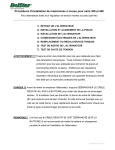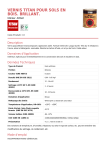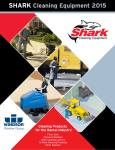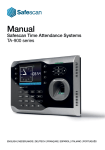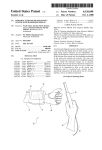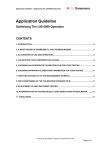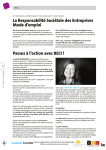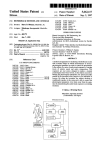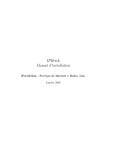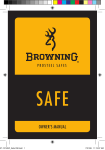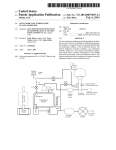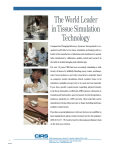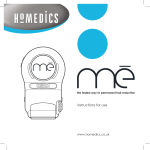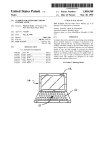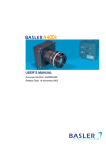Download Apparatus for treating a stain in clothing
Transcript
US 20120000809A1 (19) United States (12) Patent Application Publication (10) Pub. No.: US 2012/0000809 A1 Bischoff (54) (43) Pub. Date: APPARATUS FOR TREATINGA STAIN IN CLOTHING (76) Inventor: (21) App1.No.: . (22) 13/169,465 Int. Cl. B65D 85/00 (52) (57) _ Flled' Publication Classi?cation (51) Corey Michael Bischoff, Cincinnati’ QH (Us) Jan. 5, 2012 (200601) US. Cl. ................................................... .. 206/5241 ABSTRACT A package for treating a stained fabric. The package has a Jun‘ 27’ 2011 . . contact substrate having a ?rst color and a backing layer having a second color. More than about 25% of each of the Related U's' Apphcatlon Data WidthWise edges of the contact substrate abuts a portion of the (60) Provisional application No, 61/360,016, ?led on Jun, 30, 2010. backing layer having the second color When the package is in a generally ?at position. Patent Application Publication Jan. 5, 2012 Sheet 1 0f 12 22 300 US 2012/0000809 A1 so 30 10*“ 24 \\\\\\\\\\\\\\\ \'\\\2<\;\\\\\\ ¢/5gO \ 200 1 30 Z Fig. 2 L Patent Application Publication Jan. 5, 2012 Sheet 2 0f 12 US 2012/0000809 A1 Patent Application Publication Jan. 5, 2012 Sheet 3 0f 12 200 US 2012/0000809 A1 Patent Application Publication Jan. 5, 2012 Sheet 4 0f 12 US 2012/0000809 A1 300 80 / 70 30 ‘_—b-- wi/ 50 ~I\ 20 F 100 /| Ft’) (Ci/fl“ 100 40 200 / z Patent Application Publication Jan. 5, 2012 Sheet 5 0f 12 10“ / US 2012/0000809 A1 Patent Application Publication Jan. 5, 2012 Sheet 6 0f 12 Fig. 10 US 2012/0000809 A1 Patent Application Publication Fig. 11 Jan. 5, 2012 Sheet 7 0f 12 US 2012/0000809 A1 Patent Application Publication Jan. 5, 2012 Sheet 8 0f 12 US 2012/0000809 A1 Patent Application Publication Jan. 5, 2012 Sheet 9 0f 12 US 2012/0000809 A1 Patent Application Publication Jan. 5, 2012 Sheet 10 0f 12 US 2012/0000809 A1 Patent Application Publication Jan. 5, 2012 Sheet 11 0f 12 US 2012/0000809 A1 /s0 / /// K“, _ Fig. 18 20% 200 80 N: 80 Fig. 20 Patent Application Publication Jan. 5, 2012 Sheet 12 0f 12 / ’/////€’/52° Fig. 24 US 2012/0000809 A1 Jan. 5, 2012 US 2012/0000809 A1 APPARATUS FOR TREATING A STAIN IN CLOTHING package can have a ?rst position in Which the ?rst planar region and the second planar region are substantially in plane With one another. The package can have a second position in CROSS REFERENCE TO RELATED APPLICATIONS Which the ?rst planar region and the second planar region are in a substantially angularly facing relationship. The stain [0001] This application claims the bene?t of US. Provi sional Application No. 61/360,016 ?led Jun. 30, 2010. treatment ?uid can comprise from 0.001% to about 99.99%, FIELD OF THE INVENTION backing layer can have a second color, Wherein the ?rst color by Weight of the stain treatment ?uid, of a surfactant. The contact substrate can have a ?rst color and the ?rst side of the and the second color are measured by a Hunter Re?ectance [0002] Treating stains in clothing. Meter test according to the colors L*, a*, and b*, With L*, a*, and b* being measured on a surface of the contact substrate BACKGROUND OF THE INVENTION oriented aWay from the ?rst side of the backing layer. The [0003] Many consumers experience a stain on their cloth ing When they are aWay from home, such as might occur When contact substrate can extend betWeen a pair of opposing dining out before a theater engagement. Appearing in public With a clothing stain can be embarrassing to the Wearer. If such a stain Were to occur at home, the Wearer could choose another garment or might be able to effectively treat the stain With a stain treatment system. When aWay from her house, her options may be limited. [0004] There are presently stain treatment systems, such as pens and Wipes, that can be used to apply a stain treatment ?uid to a stain and can be used to scrub a stain. One problem associated With such devices is that stains are knoWn to some times set in fabric rapidly, thereby making treatment at a later time more di?icult. Some stains may even set in fabric to WidthWise edges on opposite sides of the line of Weakness. More than about 25% of each of the WidthWise edges can abut a portion of the backing layer having the second color When the package is in the ?rst position. The ?rst color and the second color can have a difference in color calculated using L*, a*, and b* values by the formula AE:[(L*X—L*Y)2+(a*X— a* Y)2+(b *X—b* Y)2]1/2, Wherein the AE betWeen the ?rst color and the second color is greater than about 10. BRIEF DESCRIPTION OF THE DRAWINGS [0007] FIG. 1 is a schematic of a cut-aWay perspective vieW of a package for treating a stained fabric, the package being in the ?rst position. some degree in just a feW seconds. Thus, it is important for [0008] consumers to be able to rapidly obtain a device to treat the package for treating a stained fabric, as indicated in FIG. 1. stain and rapidly understand hoW the device is to be used to treat the stain. Further, When stain treatment devices are pre sented in a retail environment, not all the attributes of the device are immediately visible to the consumer at the point of [0009] FIG. 3 is a schematic of a bottom perspective vieW of the package for treating a stained fabric illustrated in FIG. 1, ?rst side 40 being presented to the vieWer. [0010] FIG. 4 is a schematic of a package for treating a selection. For instance, Wipes for stains are often packaged in stained fabric, the package being in the second position. FIG. 2 is a schematic of a cross section vieW of the opaque foil Wrappers to protect the stain treatment ?uid and/ or Wipe from photo degradation. The consumer cannot see the Wipe or see the stain treatment ?uid. For stain treatment pens, often the scrubbing tip sometimes has a cap over it and the stain treatment ?uid is often in an opaque container. With [0012] FIG. 6 is a schematic of a side vieW of a package for treating a stained fabric. [0013] FIG. 7 is a package for treating a stained fabric, the such arrangements, prior to the consumer actively trying to package being illustrated in a second position. [0011] FIG. 5 is a schematic of a package for treating a stained fabric, the package being in the second position. use the stain treatment system, the consumer has no Way to [0014] envision hoW she Will use the stain treatment device. package being illustrated in a second position. [0005] [0015] FIG. 9 is a schematic of a side vieW of a package for treating a stained fabric. [0016] FIG. 10 is a schematic ofa side vieW ofa package for treating a stained fabric. [0017] FIG. 11 is an embodiment of the package in Which the package is devoid of a contact substrate. [0018] FIG. 12 is a cutaWay perspective of an alternate With these limitations in mind, there is a continuing unaddressed need for stain treatment devices that are easy for consumers to understand prior to use and When they need to deploy them rapidly. Further, there is a continuing unad dressed need for stain treatment devices that When presented to a consumer in a retail environment, the consumer can rapidly understand hoW the device is intended to function, can identify attributes that Will aid in stain treatment, and have a better opportunity to recall the attributes at the time she incurs a stain on her clothing. SUMMARY OF THE INVENTION [0006] A package for treating a stained fabric. The package can comprise a backing layer. The backing layer can have a ?rst side opposing a second side. The backing layer can have a line of Weakness. The second side can have a ?rst planar region and a second planar region on opposing sides of the FIG. 8 is a package for treating a stained fabric, the embodiment of the package that provides for a package that can dispense a ?rst stain treatment ?uid and a second stain treatment ?uid. [0019] FIG. 13 is a schematic of a package covered by a removable protectant. [0020] FIG. 14 is a schematic of another embodiment of a package covered by a removable protectant. [0021] FIG. 15 is a schematic of another embodiment of a package having a ?rst color and a second color. [0022] FIG. 16 is a perspective vieW of an embodiment of side of the backing layer thereby forming a pouch. The pouch the package the difference in cross-hatching of each part of the package indicating different colors of each part of the can contain a stain treatment ?uid. The package can further package. comprise a ?uid pervious contact substrate joined to the ?rst [0023] [0024] line of Weakness . A pouch layer can be joined With the second side of the backing layer proximal the line of Weakness. The FIG. 17 is a front vieW the package of FIG. 16. FIG. 18 is a rear vieW ofthe package of FIG. 16. Jan. 5, 2012 US 2012/0000809 A1 [0025] FIG. 19 is side vieW of the package of FIG. 16. [0026] FIG. 20 is a side vieW of the package of FIG. 16, opposite the side vieW shown in FIG. 19. [0027] FIG. 21 is a top vieW of the package of FIG. 16. [0028] FIG. 22 is a bottom vieW ofthe package of FIG. 16. [0029] FIG. 23 is a perspective vieW of an alternative embodiment of the package, the difference in cross-hatching of each part of the package indicating different colors of each part of the package, the side vieWs being the same as FIGS. 19 and 20, the top vieW being the same as FIG. 21, and the bottom vieW being the same as FIG. 22. [0030] FIG. 24 is a front vieW of the package of FIG. 23. that is controllably rupturable When strained. The line of Weakness 130 can be a perforation or series of perforations in the backing layer 20. The perforation or series of perforations can be formed by puncturing the backing layer 20 to form the perforation or series of perforations. The line of Weakness 130 can be an aperture formed by selectively removing mate rial from the backing layer 20. The line of Weakness 130 can be a slit that is formed by cutting the backing layer 20. In use, as the backing layer 20 is folded upon itself about the line of Weakness 130, the line of Weakness 130 can rupture. [0036] The magnitude of the bending moment needed to rupture the line of Weakness can be controlled, for instance, by the depth of the score, spacing of the perforations, dimen DETAILED DESCRIPTION OF THE INVENTION [0031] As used herein the term “joined” refers to the con dition Where a ?rst member is attached, or connected, to a second member either directly; or indirectly, Where the ?rst member is attached, or connected, to an intermediate member Which in turn is attached, or connected, to the second member either directly; or indirectly. [0032] A cutaWay vieW of a package 10 for treating a stain in a fabric is shoWn in FIG. 1. The package 10 may have any generally planar shape including a rectangle, a square, a circle, an oval, a triangle, a pentagon, a hexagon, a trapeZoid, or any other ergonomically preferred shape. A planar shape of the package 10 can provide for a package 10 that is convenient to store and is easy to securely grip prior to and during use. The package 10 can have a length direction L and a Width direction W in plane With the backing layer 20 and a Z direction orthogonal to the length direction L and Width direc tion W. The dimensions of the package 10 can be such that in sion of the aperture, dimension of the slit, Whichever such structure, or other structure, is employed if such structures are employed. If a score is employed, the score can penetrate into the backing layer 20 by about 8% to about 10% of the thick ness of the backing layer 20, the thickness being measured in the Z direction. A score, if employed, can penetrate into the backing layer 20 by less than about 15% of the thickness of the backing layer 20. [0037] The line of Weakness 130 can extend betWeen the edges of the backing layer 20, as shoWn in FIG. 1. The line of Weakness 130 can partially extend betWeen the edges of the backing layer 20. [0038] The backing layer 20 can be a material selected from the group consisting of rigid styrene, foil, BAREX (available from BP Chemicals Inc., Naperville, Ill., USA), polyethyl ene, nylon, polypropylene, and coextrudants and laminates of any of the preceding substances, and combinations thereof. The thickness of the backing layer 20 can be less than about the length direction L and Width direction W, the package has 2 mm, can possibly be less than about 1 mm, and possibly be the planar dimensions of, or smaller than, a common Wallet siZed credit card or Wallet siZed photograph. about 0.1 mm to about 0.5 mm. The backing layer can have a length betWeen about 3 cm to about 10 cm and a Width [0033] The package 10 can have a backing layer 20. Back ing layer 20 can be made of any suitably stiff material includ might be employed for package 10 designed for use at home. ing thin plastic materials such as polystyrene, polyethylene, polypropylene, or other polymeric material. Backing layer 20 joined to the ?rst side 40 of the backing layer 20 proximal the can be suf?ciently stiff to maintain package 10 in a substan tially ?at con?guration during storage and transport. In some line of Weakness 130. The contact substrate 200 can be forced into contact With the fabric to be treated during use of the embodiments, the package 10 is siZed and dimensioned to ?t conveniently in a person’s Wallet, purse, diaper bag, or package 10. The bottom of the package 10 is considered to be the side of the package 10 oriented, in use, toWards the fabric pocket. to be treated. [0034] The backing layer 20 has a ?rst side 40 opposing a second side 30, the ?rst side being toWards the bottom of the package 10. The backing layer 20 can have a line of Weakness 130. The ?rst side 40 of the backing layer 20 can have a line of Weakness 130. The line of Weakness 130 can permit the backing layer 20 to break along the line of Weakness 130 When the backing layer 20 is subjected to a su?icient bending [0040] A coating layer 50 can be joined to and facing the second side 30. The coating layer 50 can be polymer ?lm and moment. The backing layer 20 can have a ?rst elastic limit. [0035] The line of Weakness 130 can be any number of structures that provide for a controlled break in the backing layer 20 When a su?icient bending moment is applied about the line of Weakness 130. The line of Weakness 130 can be selected from the group consisting of a score, a frangible portion, perforations, a slit, an aperture, and combination thereof. When the package 10 is in a pre-use condition, the structure of the backing layer 20 can have structural integrity across the line of Weakness 130. A score can be a scratch, betWeen about 2 cm to about 6 cm. A larger backing layer 20 [0039] The package 10 can have a contact substrate 200 have a second elastic limit. The second elastic limit can be greater than the ?rst elastic limit. In other Words, the strain to break of the backing layer 20 can be less than the strain to break of the coating layer 50. The coating layer 50 can be a coextruded ?lm, one layer being a barrier layer, such as etha nol vinyl alcohol ?lm, oriented toWards the backing layer 20 and the other layer being a linear loW density polyethylene ?lm. The coating layer 50 can be a coextruded ?lm, one layer being a barrier layer, such as polyvinyl alcohol ?lm (possibly EVA ?lm Which is a copolymer of ethylene and vinyl acetate), oriented toWards the backing layer 20 and the other layer being a linear loW density polyethylene ?lm. [0041] The coating layer 50 can have a transmitting portion 60. The transmitting portion 60 can be substantially aligned With the line of Weakness 130 in backing layer 20. The trans groove, compressed portion, or other structure that structur mitting portion 60 can be any number of structures that pro ally Weakens the backing layer 20. A frangible portion can be vide for a metering opening through the coating layer 50 a series of scratches or compressed portions that structurally Weaken the backing layer 20 to make a line of Weakness 130 When the package 20 is in use. The transmitting portion 60 can be selected from the group consisting of a score, a frangible Jan. 5, 2012 US 2012/0000809 A1 portion, perforations, a slit, an aperture, and combination thereof. When the package 10 is in a pre-use condition, the transmitting portion 60 can be liquid impervious. A score can be a scratch, groove, or compressed portion that structurally Weakens the coating layer 50. A frangible portion can be a series of scratches or compressed portions that structurally White. The pouch layer 70 can be printed or otherWise labeled With a design, instruction on use, or decorative feature. The pouch layer 70 can be clear. The pouch layer 70 can be a layer of 12 um thick metaliZed polyethylene terephthalate sheet material, an adhesive layer, and a layer of linear loW density polyethylene. The pouch layer 70 can be a layer of 12 pm Weaken the coating layer to make the transmitting portion 60 rupturable When strained. The transmitting portion 60 can be a perforation or series of perforations Wherein the coating layer 50 is punctured to create the perforation or series of perforations. The transmitting portion 60 can be an aperture thick silver or aluminum foil, an adhesive, a 0.009 mm thick silver or aluminum foil, and a 0.05 mm linear loW density formed by selectively removing material from the coating The pouch layer 70 can be joined to the backing layer 20 by using any knoWn approach for attaching tWo materials includ ing, but not limited to, adhesive, glue, ultrasonic bonding, chemical bonding, thermal bonding, and fusion bonding. layer 50. The transmitting portion 60 can be a slit that is formed by cutting or tearing the coating layer 50. The coating layer can have one or more transmitting portions 60. For instance, there can be at least one, at least tWo, at least three, or more, transmitting portions 60 in the coating layer 50. A plurality of transmitting portions 60 can be practical for pro viding Wider distribution of the stain treatment ?uid 3 00 to the contact substrate 200. A line of Weakness 130 canbe provided on the ?rst side 40 of backing layer 20, second side 30 of backing layer 20, on both the ?rst side 40 and second side 30 ofbacking layer 20. A line ofWeakness 130 can be a physical and/ or chemical discontinuity internal to the structure of the backing layer 20 or on a surface of the backing layer 20. [0042] The peripheral edges of the coating layer 50 can be joined to the backing layer 20. The coating layer 50 can be polyethylene sheet material. [0046] in one embodiment, the pouch layer 70 can be joined With the backing layer 20 to form a pouch 80 there betWeen. [0047] A cross section of the package 10 illustrated in FIG. 1 is shoWn in FIG. 2. As shoWn in FIG. 2, the second side 30 of backing layer 20 has a ?rst planar region 22 and a second planar region 24 on opposing sides of the line of Weakness 130. As shoWn in FIG. 2, the transmitting portion 60 can be substantially aligned With the line of Weakness 13 0. When the backing layer 20 is broken, pouch 80 is in ?uid communica tion With the contact substrate 200, the stain treatment ?uid 300 ?oWing through the transmitting portion 60 and break in the backing layer 20 proximal the line of Weakness 130 into the contact substrate 200. The coating layer 50 can be coex substantially continuously joined to the backing layer 20 in tensive With the backing layer 20 or Within the periphery of the backing layer 20. The coating layer 50 can be at least that more than about 75% of the surface of the portion of coextensive With the periphery of the backing layer 20. coating layer 50 facing the second side 30 of backing layer 20 [0048] is joined to the second side 30 of backing layer 20. The entire surface of the portion of the coating layer 50 facing the second side 30 of backing layer 20 can be joined to the second side of 3 . As shoWn in FIG. 3, the line of Weakness 130 can be at least the backing layer 20. [0043] The package 10 can comprise a pouch layer 70 joined With the coating layer 50 to form a pouch 80 there betWeen, the pouch 80 being de?ned by the enclosed volume betWeen the pouch layer 70 and the coating layer 50. The pouch layer 70 can be joined directly to the backing layer 20 A bottom vieW of a package 10 is illustrated in FIG. partially spatially aligned With the contact substrate 200 so that When the backing layer 20 is broken, stain treatment ?uid 300 from Within the pouch 80 can be transported through the break in the backing layer 20 into the contact substrate 200. As shoWn in FIG. 3, the line of Weakness can partially extend betWeen edges of the backing layer 20. [0049] The package 10 can have a ?rst position in Which the to forma a pouch there betWeen. The pouch 80 can contain a ?rst planar region 22 and second planar region 24 of the backing layer 20 are substantially in plane With one another. stain treatment ?uid 300. The pouch layer 70 can be heat As shoWn in FIG. 4, the package 10 can be transitioned into a sealed to the coating layer 50. The pouch layer 70 can be joined to the coating layer 50 using any knoWn approach for second position in Which the ?rst planar region 22 and second planar region 24 are in a substantially angularly facing rela attaching tWo materials including, but not limited to, adhe tionship. By substantially angularly facing relationship it is sive, glue, ultrasonic bonding, chemical bonding, thermal bonding, and fusion bonding. meant that the ?rst planar region 22 and the second planar [0044] interior angle [3 of less than about 90 degrees, the interior The pouch layer 70 can be a bloWn ?lm or cast ?lm. The pouch layer 70 can be liquid impervious and can be durable enough to prevent penetration or rupture of the pouch layer 70. The pouch layer 70 and coating layer 50 can also be chemically compatible With the stain treatment ?uid 300 con tained Within the pouch 80. That is, the coating layer 50 and pouch layer 70 can be substantially inert to the stain treatment ?uid 300 contained therein and the external environment for a duration su?iciently long to provide for chemical and mechanical stability from the time When the package is manu region 24 are disposed With respect to one another at an angle [3 being measured betWeen the ?rst planar region 22 and the second planar region 24 on the second side 30 of the backing layer 20. [0050] In the ?rst position, at least a portion of the ?rst planar region 22 and the second planar region 24 can be integral With one another. The backing layer 20 can be at least partially intact across the line of Weakness 130. In the second position at least a portion of the backing layer 20 can be discontinuous across the line of Weakness 130. In the second factured to the time When the package 10 is used to treat a stain. The pouch 80 can contain a volume of stain treatment ?uid 300. [0045] The pouch layer 70 can be a single layer or a lami position, the backing layer 20 can be broken at, proximal to, nate of multiple layers. The pouch layer 70 can comprise foil. package 10 can conveniently be carried in a pocket, a pocket The pouch layer 70 can be a layer of 12 pm thick sheet material, an adhesive layer, and a layer of 0.06 mm thick of a Wallet, pocket of a purse, or an auto glove compartment. linear loW density polyethylene. The pouch layer 70 can be or along the line of Weakness 130 so that the pouch 80 is in ?uid communication With the contact substrate 200. [0051] When the package 10 is in the ?rst position, the The generally ?at nature of the package 10 provides for a pro?le that is not bulky and can be stored conveniently. Jan. 5, 2012 US 2012/0000809 A1 [0052] As shown in FIG. 4, in the second position, the transmitting portion 60 can be ?uid pervious. The transmit ting portion 60 can be ?uid pervious, for instance, as a result of a slit in the coating layer 50. As shoWn in FIG. 4, the transmitting portion 60 can be a slit that can be slightly stretched open. In the second position, the ?rst planar region 22 and the second planar region 24 can be disposed at an interior angle [3 of less than about 45 degrees, measured betWeen the ?rst planer region 22 and the second planar region 24. The transmitting portion 60 can have a variety of embodiments that provide for ?uid communication through the coating layer 50. In the second position, the ?rst planar region 22 and the second planar region 24 can be disposed at an interior angle [3 of less than about 10 degrees, alternatively at an interior angle [3 of less than about 5 degrees, alternatively at an interior angle [3 of less than about 1 degree. In the second position, the ?rst planar region 22 and the second planar region 24 canbe disposed at an interior angle [3 betWeen about Zero degrees and about 5 degrees. [0053] In the second position, the pouch 80 can be folded upon itself and pressure applied through the ?rst planar region 22 and the second planar region 24 can extrude out the stain treatment ?uid 300 contained Within the pouch 80. As the ?rst planar region 22 and second planar region 24 are brought in closer angular facing relationship, more of the stain treatment ?uid 300 contained Within the pouch 80 can be expressed or extruded. Once a signi?cant squeezing force is applied by the user, the ?rst planar region 22 and secondplanar region 24 can be pressed toWards one another driving out stain treatment toWards one another by the user, the stain treatment ?uid 300 is dispensed to the contact substrate 200 through the portion of the backing layer 20 that is discontinuous across the line of Weakness 130. The backing layer 20 is gripped, for instance in a manner similar to that shoWn in FIG. 5, and the user rubs the stained fabric With the contact substrate 200. [0057] To alloW more of the contact substrate 200 to contact the stained fabric, the contact substrate 200 can be joined to the backing layer 20 by one or more hinges 100, as shoWn in FIG. 6. By employing a hinged arrangement, the contact substrate can remain relatively ?at even as the backing layer 20 is bent or folded about the line of Weakness 130. Each hinge 100 can be formed from a ?exible material that alloWs a variable distance to be de?ned betWeen the backing layer 20 and the contact substrate 200. Each hinge 100 can be joined in part to the ?rst side 40 and joined in part to the contact substrate 200. When the backing layer 20 is in a planar con dition prior to being used to treat a stain, each hinge 100 can be closed, for example by a single bend or multiple folds in the relevant hinge 100. When each hinge 100 is closed, the contact substrate 200 can be in facing relationship With the backing layer 20, Which can provide for a compact package 10. Each hinge 100 can be constructed from a piece of ?exible material that is folded upon itself to have a nearly planar shape before the package is transitioned from the ?rst position to the second position. [0058] When the backing layer 20 is broken andpackage 10 is transitioned from the ?rst position to the second position by ?uid 300 from the pouch 80, through the transmitting portion bringing the ?rst planar region 22 and the second planar region 24 into a substantially angularly facing relationship, 60 and into the contact substrate 200. The backing layer 20 each hinge 100 can open to provide for a portion the contact folded upon itself can provide for a convenient gripping struc ture for the user of the package 10 to grasp as she rubs the contact substrate 200, if present, back and forth across the stain on the fabric being treated. substrate 200 to be spaced apart from the backing layer, as shoWn in FIG. 7. When the package is in the second position, [0054] In the second position, the gripping structure pro vided by the backing layer 20 folded upon itself can alloW the consumer to effectively use the package 10 to treat a stain, Without having her hand contact the stain treatment ?uid 300 or contact substrate 200. Further, such gripping structure can provide for a sturdy structure that the consumer can rub back and forth vigorously, thereby rubbing the contact substrate 200 or edges of the broken backing layer 20, if a contact substrate is not present, against the stain. [0055] The second elastic limit of the coating layer 50 can be greater than the ?rst elastic limit of the backing layer 20. Such a design can provide for a mechanical arrangement in Which When the coating layer 50 and backing layer 20 joined together are strained, the backing layer 20 can break before the coating layer 50. Such an arrangement can be desirable because once the backing layer 20 breaks, the coating layer 50 can provide for maintaining the structural integrity of the each hinge 100 can have a generally “U” or “V” shape in cross-section, as shoWn in FIG. 7. Such an arrangement can provide for a conduit to direct stain treatment ?uid 300 from the pouch 80 to the contact substrate 200 With limited accu mulation of the stain treatment ?uid 300 in other components of the package 10. Each hinge 100 can be considered to have tWo legs, one of Which is joined to the backing layer 20 and one of Which is joined to the contact substrate 200. The legs of each hinge 100 joined to the contact substrate 200 can be substantially coextensive With contact substrate 200 in that more than about 90% of the side of the contact substrate 200 facing the backing layer is joined to a hinge 100. A leg of each hinge 100 can be joined to the contact substrate 200 or the backing layer 20 using any knoWn approach for attaching tWo materials including, but not limited to, adhesive, glue, ultra sonic bonding, thermal bonding, and fusion bonding. To pro vide for a more durable package 10, the approach for joining each hinge 100 can be chemically compatible With the stain stain treatment ?uid 300 can be metered through the trans treatment ?uid 300. Each hinge 100 can be a polypropylene based tape such as 3M 3560, available from 3M. [0059] Each hinge 100 can be an integral extension of the contact substrate 200 and comprise the same constitutive mitting portion 60. The transmitting portion 60 can have a material as the contact substrate 200, as illustrated in FIG. 8. package 10 and the transmitting portion 60 of the coating layer 50 can be remain bounded by coating layer 50 such that shape that provides for controlled ?uid ?oW there through. Such arrangement might provide for ease of manufacture by [0056] reducing the number parts that must be assembled to form the A stained fabric employing the package 10 can be treated by bending the backing layer 20 about the line of package 10. Weakness 130 to move the ?rst planar region 22 and the [0060] A foundation layer 110 can be joined to the contact substrate 200 and the backing layer 20, as shoWn in FIG. 9, such that the foundation layer 110 is betWeen the contact substrate 200 and the backing layer 20 and the hinges 100, if present, are joined to the foundation layer 110. The founda second planar region 24 into a substantially facing relation ship, thereby making a portion of the backing layer to be discontinuous across the line of Weakness 130. As the ?rst planar region 22 and the second planar region 24 are pressed Jan. 5, 2012 US 2012/0000809 A1 tion layer 110 can provide for enhanced structural stability of the package 10 When the contact substrate 200 is vigorously rubbed against a stained fabric. The foundation layer 110 can be, for example, a Web of ?uid permeable material, or mate rial rendered to be selectively ?uid permeable proximal the The thickness of the distribution layer can be determined folloWing EDANA Recommended Test Method: NonWovens line of Weakness 130, that is about coextensive With or later ally Within the contact substrate 200 in the length direction L a stainless steel test sieve of 2 mm nominal mesh siZe accord ing to ISO 565, that is about 120 mm><120 mm and a dish for and Width direction W. The foundation layer 1 10 can be a Web of ?uid permeable material that is coextensive With the con tact substrate 200 in the length direction L and Width direction W [0061] The foundation layer 110 can be joined to the back ing layer 20 through each hinge 100 using any knoWn approaches for joining tWo materials, including, but not lim ited to, adhesive, glue, ultrasonic bonding, thermal bonding, chemical bonding, and fusion bonding. Similarly, the foun dation layer 110 can be directly joined to the contact substrate 200 using any knoWn approaches for joining tWo materials, including, but not limited to, adhesive, glue, ultrasonic bond ing, thermal bonding, chemical bonding, and fusion bonding. The foundation layer 110 can be joined to the contact sub strate 200 through one or more intermediate layers. The foun dation layer 110 can be a Web of material selected from the group consisting of a porous ?lm, a slit ?lm, an apertured ?lm, a nonWoven, a Woven, and combinations thereof. The foundation layer 110 can be a polyethylene based material such as DELNET AC 530-NAT-E, high density polyethylene based substrate, having a basis Weight of 18 g/m2, and 0.12 mm thick, available from DelStar Technologies, Inc. [0062] In some embodiments, a distribution layer 120 can be disposed in facing relationship With the contact substrate 200 and betWeen the backing layer 20 and the contact sub strate 200, for example, as shoWn in FIG. 10. The distribution layer 120 can provide for extensive distribution in the length direction L and Width direction W of the stain treatment ?uid 300 into and/ or through the contact substrate 200. To promote delivery of the stain treatment ?uid 300 to the fabric being treated, the distribution layer 120 can have a free absorbent capacity that is less than the volume of stain treatment ?uid 300 contained in the pouch 80. The distribution layer 120 can comprise a hydrocarbon based ?brous material. The distribu tion layer 120 can comprise a ?brous material selected from the group consisting of polyethylene, polypropylene, nylon, polyethylene terephthalate, rayon, and combinations thereof. The distribution layer 120 can be joined to the contact sub strate 200, for instance by any knoWn approaches for attach ing tWo materials, including, but not limited to, adhesive, glue, ultrasonic bonding, thermal bonding, chemical bond ing, and fusion bonding. The distribution layer 120 can be a needle punched ?brous material. The distribution layer 120 can be a polypropylene needle punched nonWoven having a basis Weight of 150 g/m2. The basis Weight can be determined folloWing EDANA Standard Test: WSP 130.1 (05), Standard Test Method for Mass per Unit Area, on a 1 cm><1 cm sample and using a balance accurate to 0.0001 g. The basis Weight is Thickness (305-99). [0063] The free absorbent capacity of the distribution layer 120 is measured as folloWs. The apparatus required includes containing the Wire gauZe With the test sample. The dish must be of su?icient volume to alloW a test liquid depth of 20 mm. The test liquid is 10% Sodium Dodecyl Sulfate solution in distilled Water. A suitable Weighing glass and cover are used. A balance having an accuracy of plus or minus 0.01 g and a stop Watch are also needed. [0064] The test is conducted in a laboratory With an ambi ent temperature of 25.0102o C. and relative humidity 50:5%. All apparatus and samples are equilibrated in the testing environment for tWo hours. The test dish is covered to prevent excessive evaporation. A representative rectilinear sample of the distribution layer 120 With a Weight of 1 .0010. 05 grams is cut from the distribution layer material taking care not to compress or otherWise perturb the structure. The length divided by the Width of the sample must be less than 2, With the length being the longer side of the sample. If an individual distribution layer 120 is not of suf?cient dimen sions to prepare such test pieces, more than one distribution layer 120 from more than one package 10 can be combined to provide a stack of rectilinear test pieces With the required Weight and aspect ratio. Each test piece, or stack of pieces, is Weighed on a balance having an accuracy of 0.01 g. A test piece (or stack) is placed on the Wire gauZe and is fastened thereto by a suitable clip along the Width edge (i.e. Within 1 mm of the edge of the material along the shorter dimension in the plane of the material). The Wire mesh and attached sample are introduced to the test liquid at an oblique angle With the sample facing upWards. Once submerged, the gauZe is placed horiZontally 20 mm beloW the surface of the test liquid. This is conveniently achieved if the dish has a ?at bottom and the test ?uid is 20 mm deep. After sixty seconds, plus or minus one second, the gauZe and test piece (or stack) are removed from the test liquid and hung freely to drain for one hundred and tWenty seconds, plus or minus three seconds. The sample is oriented so that the clip is at the top horizontal edge of the sample during the draining step. After draining, the test piece (or stack) is separated from the gauZe Without squeeZing ?uid from the test piece or stack. The mass of test piece (or stack) is then determined to Within 10.1 gram. The difference betWeen the mass of the test piece or stack prior to Wetting, and the mass of the test piece or stack after Wetting is the free absorbent capacity of the material in grams of ?uid absorbed per gram of material. This is converted to volume of ?uid absorbed per gram of material by using 1 g/cm3 as the test liquid density. The free absorbent capacity is taken to be the mean of ?ve measurements made folloWing this procedure. Freshly conditioned test liquid is used for each set of ?ve measurements. [0065] Embodiments of the package 10 in Which the pack age 10 is devoid of a contact substrate 200, as shoWn in FIG. determined based upon 5 samples combined and calculating 11, are also contemplated. When the package 10 is positioned an average from the combined Weight/ area. The distribution layer 120 and foundation layer 110 can be a composite mate in the second position by breaking the backing layer 20 along rial. STRATEX 5.0NP5-E, a composite substrate made by DelStar Technologies, Inc., can provide for a single product that includes both the distribution layer 120 and foundation layer 110. This distribution layer 120 can be 1.5 mm thick. the line of Weakness 130, stain treatment ?uid 300 can ?oW through the discontinuity created in the backing layer 20. In other Words, in the second position, the pouch 80 can be in ?uid communication With the ?rst side 40 of the backing layer. In the second position, the stain treatment ?uid 300 can Jan. 5, 2012 US 2012/0000809 A1 be expelled through the portion of the backing layer 20 that is strip releaseably joined to the backing layer 20. The contact discontinuous across the line of Weakness 130. In such an substrate 200 is considered to be substantially covered When embodiment, the stain treatment ?uid 300 could be a gel to more than about 75% of the surface of the contact substrate provide for improved control of application of the stain treat 200 oriented aWay from the ?rst side 40 of the backing layer 20 is covered. The protectant 400 can be comprised of, for example, ?lm, paper, ?brous nonWoven, foil, or any other ment ?uid 300. As or after the ?uid is applied to the fabric being treated, the broken edge of the backing layer 20 can be scraped back and forth against the fabric being treated, thereby applying and distributing the stain treatment ?uid 3 00 to the stain and potentially dislodging agglomerations/glob ules of the stain, bleaching the stain, and/or brightening the fabric. [0066] A stained fabric can be treated by employing the package 10 illustrated in FIG. 11 by bending the backing layer 20 about the line of Weakness 130 to move the ?rst planar region 22 and the second planar region 24 into a substantially facing relationship, thereby making a portion of the backing layer to be discontinuous across the line of Weak ness 130. As the ?rst planar region 22 and the second planar region 24 are pressed toWards one another by the user, the stain treatment ?uid 300 is dispensed to the ?rst side 40 of the hacking layer 20 through the portion of the backing layer 20 that is discontinuous across the line of Weakness 130. The backing layer 20 is gripped, for instance in a manner similar to that shoWn in FIG. 5, and the user rubs the stained fabric With the portion of the backing layer 20 that is discontinuous across the line of Weakness 130. [0067] FIG. 12 is a cutaWay perspective of an alternate embodiment of the package 10 that provides for a package that can dispense a ?rst stain treatment ?uid 301 and a second stain treatment ?uid 302. This arrangement might be practical in that tWo materials that interact favorably or provide for treatment ef?cacy for different types of stains can be dis pensed. For instance, the ?rst stain treatment ?uid 301 might provide for effective treatment of hydrophobic grease stains and the second stain treatment ?uid 302 might provide for effective treatment of hydrophilic Wine stains, for instance by bleaching. The ?rst stain treatment ?uid 301 might be a deter gent and the second stain treatment ?uid 302 might be a bleach compound. Such an arrangement might be bene?cial for stain treatment ?uid components are not stable or lose e?icacy When stored together for prolong periods of time. Such an arrangement might be bene?cial for stain treatment ?uid components that have optimum ef?cacy under different local conditions (eg pH). The pouch layer 70 can be joined With the backing layer 20, or to the coating layer 50 if present, thereby forming a ?rst pouch 81 and a second pouch 82. The ?rst pouch 81 and the second pouch 82 can be separated by a separating portion 83. The separating portion 83 can be gen suitably durable material that can Withstand the Wear and tear that might occur to such protectant 400 containing the pack age 10 prior to use. The protectant 400 might limit damage to the package 10 due to the package 10 being carried in a Wallet, purse, pocket, diaper bag, auto glove compartment, or other such location that package 10 might be in prior to use. The protectant 400 might be releasably joined to the ?rst side 40 of the backing layer 20 by an adhesive. The protectant 400 might be releasably joined to the backing layer 20 using any knoWn approach for attaching tWo materials including, but not lim ited to, adhesive, glue, ultrasonic bonding, chemical bonding, thermal bonding, and fusion bonding. [0069] The package 10 can be a dispensing package such as that disclosed in US. Pat. No. 7,506,762 B2. The package 10 can be a dispensing package such as that disclosed in US. Patent Pub. No. 2009/0074502 A1. [0070] In one embodiment, the contact substrate 200 can be a polypropylene/polyethylene 70/30 holloW 16 segmented pie micro?ber from ES Fibervisions/Chisso, referred to as code 020 having a ?ber diameter of 2.2 denier, ?ber length of 51 mm, and a basis Weight of 60 g/m2. In one embodiment, the contact substrate can be selected from the group consisting of a foam, a ?brous material, a ?lm, a brush, and combinations thereof. Without being bound by theory, it is thought that a contact substrate 200 that presents a rough surface to the fabric being treated can improve stain treatment because the rough surface can aid With dislodging the stain from the fabric. [0071] A contact substrate 200 comprising micro ?bers can provide for effective stain removal. Without being bound by theory, it is thought that the micro ?bers provide for smaller interstitial spaces betWeen the ?bers making up the contact substrate, such smaller spaces being able to hold greasy mate rials more effectively than a contact substrate 200 consisting of larger ?bers. In one embodiment, the contact substrate 200 can comprise micro ?bers having a diameter betWeen about 0.1 micrometers and about 5 micrometers. In one embodi ment, the contact substrate 200 can comprise micro?bers having a diameter less than about 5 micrometers. The micro ?bers can be notched-pie micro ?bers, Which have sharp ?ber edges that are generated during formation of such micro erally aligned parallel With the line of Weakness 130, gener ?bers. The micro ?bers can be staple ?bers or continuous ally orthogonal to the line of Weakness 130, or otherWise generally aligned With the line of Weakness 130. The ?rst splitted ?bers. The micro ?bers can be split polypropylene polyethylene micro ?bers. pouch 81 can contain the ?rst stain treatment ?uid 301 and the second pouch 82 can contain the second stain treatment com group consisting of polyethylene, polypropylene, nylon, position 302. A portion of the separating portion 83 can intersect a portion of the line of Weakness 130. [0068] The package 10 can be covered by a removable protectant 400, for instance as shoWn in FIGS. 13 and 14. The ?rst side 40 of backing layer 20 can be at least partially covered by a removable protectant 400. The removable pro tectant 400 can be selected from the group consisting of a Wrap Wrapped around the backing layer 20 and substantially [0072] The contact substrate 200 can be selected from the polyethylene terephthalate, rayon, and combinations thereof. Such ?ber types are thought to possibly provide for stain lifting due to their molecular makeup. The contact substrate can be selected from the group consisting of a nonWoven comprising micro?bers, a Woven comprising micro?bers, a looped Woven comprising micro?bers, and combinations thereof, With micro ?bers being practical as discussed above. [0073] The composition of stain treatment ?uid 300 may be covering the contact substrate 200, a slip liner at least partially one knoWn in the art for stain treatment such as compositions enclosing the package 10, an envelope enclosing the package containing a chelating agent, radical scavenger and prefer 10, a sealed packet enclosing the package 10, and a release ably a bleach disclosed in US. Pat. No. 6,846,332. Jan. 5, 2012 US 2012/0000809 A1 [0074] The composition of stain treatment ?uid 300 can be the longitudinal axis LA, The longitudinal axis LA is gener aqueous or non-aqueous. In one embodiment the composition ally aligned directionally With the length direction L. comprises from 0% to about 99.99%, alternatively from about [0082] The ?rst color 520 and second color 530 are mea sured by a Hunter Re?ectance Meter Test according to the 70% to about 99.99%, alternatively from about 90% to about 99.9%, alternatively from about 94.0% to about 99.0%, by colors L*, a*, and b* With L*, a*, and b* being measured on Weight, of Water and therefore be aqueous solutions. [0075] The composition of stain treatment ?uid 300 can a surface of the contact substrate 200 oriented aWay from the ?rst side 40 of the backing layer 20. comprise additional components such as bleach, surfactant, solvent, chelating agents, radical scavengers, and mixtures have a difference in color calculated using L*, a*, and b* thereof. [0076] The contact substrate 200 can have at least one side that is light colored. A light colored contact substrate 200 can function as an indicator that the stain being treated is being effectively lifted from the fabric being treated and being transferred to the contact substrate 200. As the contact sub strate 200 acquires the stain, the color of the contact substrate may tend to darken. For stains on patterned fabrics, Which may be hard to see in loW lighting situations, such as a res taurant, Where stains are likely to occur, having a light colored contact substrate 200 that darkens When used can help the user of the contact substrate monitor that the stain is being removed. [0077] A contact substrate 200 can have a L* value greater than about 80. A contact substrate 200 can have an L* value greater than about 85. A contact substrate 200 can have an L* value greater than about 90. A contact substrate 200 can have an L* value greater than about 95 . A contact substrate 200 can have an L* value of greater than about 90 and an a* value betWeen about —5 and about 5 and a b* value betWeen about —5 and about 5. [0078] The color of a contact substrate 200 is measured by the re?ectance spectrophotometer according to the colors L*, a*, and b* values. If the contact substrate 200 is joined to a backing layer 20, the L*, a*, and b* values of the contact substrate 200 are measured on the side of the contact substrate 200 that is oriented aWay from the backing layer 20. [0079] Re?ectance color is measured using a Hunter Re?ectance Meter test that employs using the Hunter Lab LabScan XE re?ectance spectrophotometer obtained from Hunter Associates Laboratory of Reston, Va. A contact sub [0083] The ?rst color 520 and the second color 530 can values by the formula AE:[(L*X—L* Y)2+(a*X—a*Y)2+(b *X— b*Y)2]l/2, Wherein the AE betWeen the ?rst color 520 and the second color 530 is greater than about 10. Herein, the ‘X’ in the equation can represent the contact substrate 200 or the ?rst side 40 of the backing layer 20. ‘Y’ in the equation can represent the contact substrate 200 or the ?rst side 40 of the backing layer 20. ‘X’ and ‘Y’ are not to be the same object. In other Words, for any particular evaluation of the difference in color, the location of‘X’ is not the same as the location of ‘Y’. [0084] A difference in color of AE greater than about 10 provides a difference in color that can appear distinct to an observer. The greater the AE betWeen the ?rst color 520 and second color 530, the more readily distinguishable the tWo colors are. The AE betWeen the ?rst color 520 and second color 530 can be greater than about 20. The AE betWeen the ?rst color 520 and second color 530 can be greater than about 30. The AE betWeen the ?rst color 520 and second color 530 can be greater than about 40. The AE betWeen the ?rst color 520 and second color 530 can be greater than about 50. The AE betWeen the ?rst color 520 and second color 530 can be greater than about 55. The AE betWeen the ?rst color 520 and second color 530 can be greater than about 60. The AE betWeen the ?rst color 520 and second color 530 can be greater than about 65. The AE betWeen the ?rst color 520 and second color 530 can be greater than about 70. The AE betWeen the ?rst color 520 and second color 530 can be greater than about 80. The AE betWeen the ?rst color 520 and second color 530 can be greater than about 90. The difference in color AE betWeen the ?rst color 520 and second color 530 can be greater than any integer number greater than 10. [0085] By having a AE betWeen the ?rst color 520 and the second color 530, the contact substrate 200 visually stands out from the ?rst side 40 of backing layer 20 so that the user can easily recogniZe the location of the substrate. One could strate 200 is tested at an ambient temperature betWeen 65° F. and 75° F. and a relative humidity betWeen 50% and 80%. [0080] The spectrophotometer is set to the CIELab color scale and With a D65 illumination. The Observer is set at 10° and the Mode is set at 45/0°. Area VieW is set to 0.125" and Port SiZe is set to 0.20". The spectrophotometer is calibrated the both the backing layer 20 and the contact substrate 200 be a brilliant White, Which might be desirable given that the prior to sample analysis utiliZing the black glass and White package 10 is designed to treat stains on fabric. In such an reference tiles supplied from the vendor With the instrument. Calibration is done according to the manufacturer’s instruc contemplate an embodiment that may look sanitary by having embodiment, the user might not be able to quickly identify tions as set forth in LabScan XE User’s Manual, Manual Where the contact substrate 200 for scrubbing the stain is on the package 10. Further, in a retail environment, if such a Version 1.1, August 2001, A60-1010-862. If cleaning is package 10 is presented to the consumer, it may challenging required of the reference tiles or samples, only tissues that do not contain embossing, lotion, or brighteners should be used (e.g., PUFFS tissue). Any sample point on the contact sub strate 200 facing aWay from the ?rst side 40 of the backing for the consumer to recogniZe the existence of the contact layer 20 can be selected. substrate 200 and hoW the package 10 is designed to function, particularly When vieWed at a distance of 1 m or more from the package 10. considered to have a longitudinal axis LA and a transverse [0086] As shoWn in FIG. 15, the contact substrate can extend betWeen a pair of opposing WidthWise edges 500 on opposite sides of the line of Weakness 130. For a rectangular contact substrate 200, the WidthWise edges 500 can be sub stantially parallel to the transverse axis T. The contact sub strate can have a pair of opposing lengthWise edges 510. The periphery of the contact substrate 200 can be bound by the axis T, the transverse axis T is orthogonal to and intersecting pair of WidthWise edges 500 andpair of lengthWise edges 510. [0081] To improve the ability for the user to identify the appropriate portion of the package 10 to use for treating a stain, the contact substrate 200 can have a ?rst color 520 and the ?rst side 40 of the backing layer 20 can have a second color 530, as shoWn in FIG. 15. The package 10 can be
























